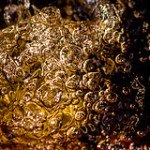 Many people have heard of tannins in relation to wine: they are what gives wine its “dry” taste. But did you know that tannins are also a form of water contamination? As it turns out, high levels of tannins can affect the taste and smell of tap water, in addition to causing some problems around your home. Today we’re going to talk about what tannins are, how they get into your home’s water and what you can do to remove tannins from the water in your home!
Many people have heard of tannins in relation to wine: they are what gives wine its “dry” taste. But did you know that tannins are also a form of water contamination? As it turns out, high levels of tannins can affect the taste and smell of tap water, in addition to causing some problems around your home. Today we’re going to talk about what tannins are, how they get into your home’s water and what you can do to remove tannins from the water in your home!
What are tannins?
Tannins are decayed organic matter that has dissolved into water. They are often found in surface water supplies like lakes and rivers. When water runs over decayed organic matter (from vegetation or animals) the tannins are picked up and dissolved into the water.
How do tannins get into your home’s tap water?
Tannins are considered a secondary contaminant by the EPA, which means they are not regulated. As a result, they can end up in homes that get their source water from rivers and lakes that contain high levels of tannins. In addition, tannins can seep underground and get into private wells if the wells have cracks in their walls.
How do you know if your home’s water contains tannins?
- Your water has a yellow or brown tint to it, often looking like tea.
- Your toilet bowls and sinks have yellow stains from the water that comes into contact with them.
- Your clothes have yellow stains after they are washed in your washing machine.
- Your water has a musty smell.
- Your water tastes bitter or tart.
- You had your water tested by EPA Water and the results showed high levels of tannins.
What are the effects of tap water with high levels of tannins?
Luckily, there are no health concerns related to tannins in water. As you can tell from the list above, most of the problems with tannins are that they make your water unpalatable to drink and they can stain your plumbing surfaces and clothes.
However, high levels of tannins in water can be an indication that other types of contaminants might be present in your water. If tannins were able to make it past water treatment systems and into your home, then there’s a chance that other contaminants like bacteria might be in your water as well. If you suspect that your home’s water might contain tannins, be sure to have it tested by a professional water quality analyst like EPA Water.
How can you remove tannins from your home’s water?
Tannins can easily be removed by installing a water filtration system in your home. Carbon filtration has proven to be very effective at removing tannins. We suggest installing a whole house system to remove tannins, because that will prevent staining of your plumbing fixtures and clothes. If a whole house system doesn’t currently fit your budget, a point-of-use system will at least remove tannins from one tap and give you access to clear, odorless and great-tasting water.
If you have any questions about tannins in your water, or if you’d like a water system serviced or installed in your home, contact EPA Water Consultants, your water softener and water filtration system dealer in Pennsylvania and New Jersey. We provide service all over Eastern Pennsylvania and New Jersey, including towns like Malvern, Quakertown and Allentown, PA.
photo credit: andryn2006 via photopin (license)
